- I’m Tired, Overwhelmed, and Burnt Out
- Recipes: Where to begin?
- Recipes: What do we cook this week?
- Grocery Shopping: Making a Better List
- Grocery Shopping: Adding New Recipes to Reminders
- Results
For the longest time, I didn’t enjoy cooking. At the end of a long day, cooking in the kitchen by myself and then cleaning up all the dishes was not at all appealing. Instead, I prioritized spending time with friends, going to the gym, practicing yoga, etc. I don’t think that there was anything inherently wrong with this. One can generally solve things with time or money and this was a place where I wanted to spend my time elsewhere.
Things changed when my partner moved in with me. We discovered that we had good “kitchen chemistry” and that cooking felt a little less like a chore. Still, we both found ourselves ordering out more often than we wanted, both for budget and health. We were stressed and exhausted from with work (he is also doing grad school!) and even the smallest amount of friction got in our way. It might sound silly, but making decisions about what to cook, making the list for the store, going grocery shopping, and then cooking and cleaning often felt like a little too much – especially on a weeknight.
I wanted to figure out how I could help us to cook more at home.
I’m Tired, Overwhelmed, and Burnt Out
I spent some time mapping out what was getting in the way of me cooking at home regularly. I tried a “Five Whys” approach starting with the question of, “Why don’t I cook at home more often?” I found (or reminded myself) that:
- finding recipes was overwhelming (Too many choices!)
- choosing what to cook was a chore (Yes, I was that burnt out!)
- making the grocery list with all the ingredients felt overwhelming (Yes, I did find a great therapist!)
- sharing a single list with my partner while grocery shopping slowed us down (Again, I was very tired.)
- there’s a feedback loop between exercise and eating well (Not a surprise, but critical piece to consider.)
I can’t recommend the process of visualizing enough. When I’m running on fumes, it’s harder to work out complex problems in my head – and challenging to remember my plan for addressing the problem later! By taking the problem out of my brain and putting it on paper, I allowed myself to focus on one thing at a time and made it easier for my future self. It was through this process that I started to think about all of these activities and dependencies as a system. To achieve my goal and set myself up for future success, I needed to engineer a new system that would be both sustainable and resilient.
In the sections that follow, I’ll discuss how I worked through each of the points above.
Recipes: Where to begin?
As a people manager and leader in my last role, I frequently ended the day with decision fatigue. The thought of choosing one from the seemingly infinite number of recipes on the internet was harrowing. When I focused on this problem specifically, I knew that I had to dramatically reduce the number of options I was considering. I had a few ideas, including:
- asking friends for a favorite recipe that was easy, quick, and healthy
- buy a cookbook from an author I know we like
- enroll in a cooking class
- pay an expert to develop a plan for me
Ultimately, we went with a combination of 1 and 2, as it was the easiest and least expensive. My good friends and former housemates, Anthony and Barry, are big fans of Melissa Clark and I became a big fan too. (When we lived together, we had a great deal where they cooked and I did dishes and covered my portion of the groceries for meals. 💖) We got some recommendations for Melissa Clark cookbooks and bought a few to begin our adventure:
- Kid in the Kitchen: Hear me out. Clark wrote this for kids 8-14 with recipes that are simplified, but not simplistic. I found that this was a great entry point for doing more cooking on my own because things were so easy, but still tasted great. It was a great confidence builder.
- Dinner in an Instant: This is Clark’s cookbook for pressure-cooker recipes. They’re quick, straight-foward, and delicious – perfect for weeknights.
- Comfort in an Instant: This second pressure-cooker book focuses on comfort food. Again, everything comes together pretty quickly and is great for weeknights when you’re stressed out and want some comfort food.
I think it’s worth noting that by choosing one author and having sampled a variety of her recipes already, we knew that we liked her taste. Similarly, there’s a core set of spices and kitchen tools that Clark uses over and over, so we didn’t have to buy 300 different things that we didn’t know if we would use again.
We started out by choosing some recipes that we had eaten before (when friends cooked them) so we could build our confidence. We found that it was nice having some go-tos that weren’t fussy and came together quickly. Over time, we experimented with new recipes from within these cookbooks as well as pulling new recipes from New York Times Cooking to add in some new authors and flavors. Signing-up for the NYTimes Cooking Newsletter (this is not a paid promotion!) has also been really helpful. It’s a nice way to get a short, seasonal list of recipes to look through each week.
TL;DR: To make recipe selection more approachable when starting out:
- lean on friends and family whose cooking you adore to find a recipe author you like
- buy their cookbook to limit your options
- build a core repertoire of quick, easy recipes to build confidence and get time back
- slowly introduce new recipes from the same author from the same cookbook
- slowly introduce new recipes from new authors through a newsletter / blog
Recipes: What do we cook this week?
The next thing I wanted to cover was selecting our recipes each week. It was important that our solution would be:
- fast to complete
- easy to maintain
- simple to do even when stressed or low energy
- collaborative so my partner and I could do it together
I considered some electronic options, but wanted something that we’d have in the physical world to remind us of our decisions. I suppose I owe it working in tech for the approach we ended up taking:
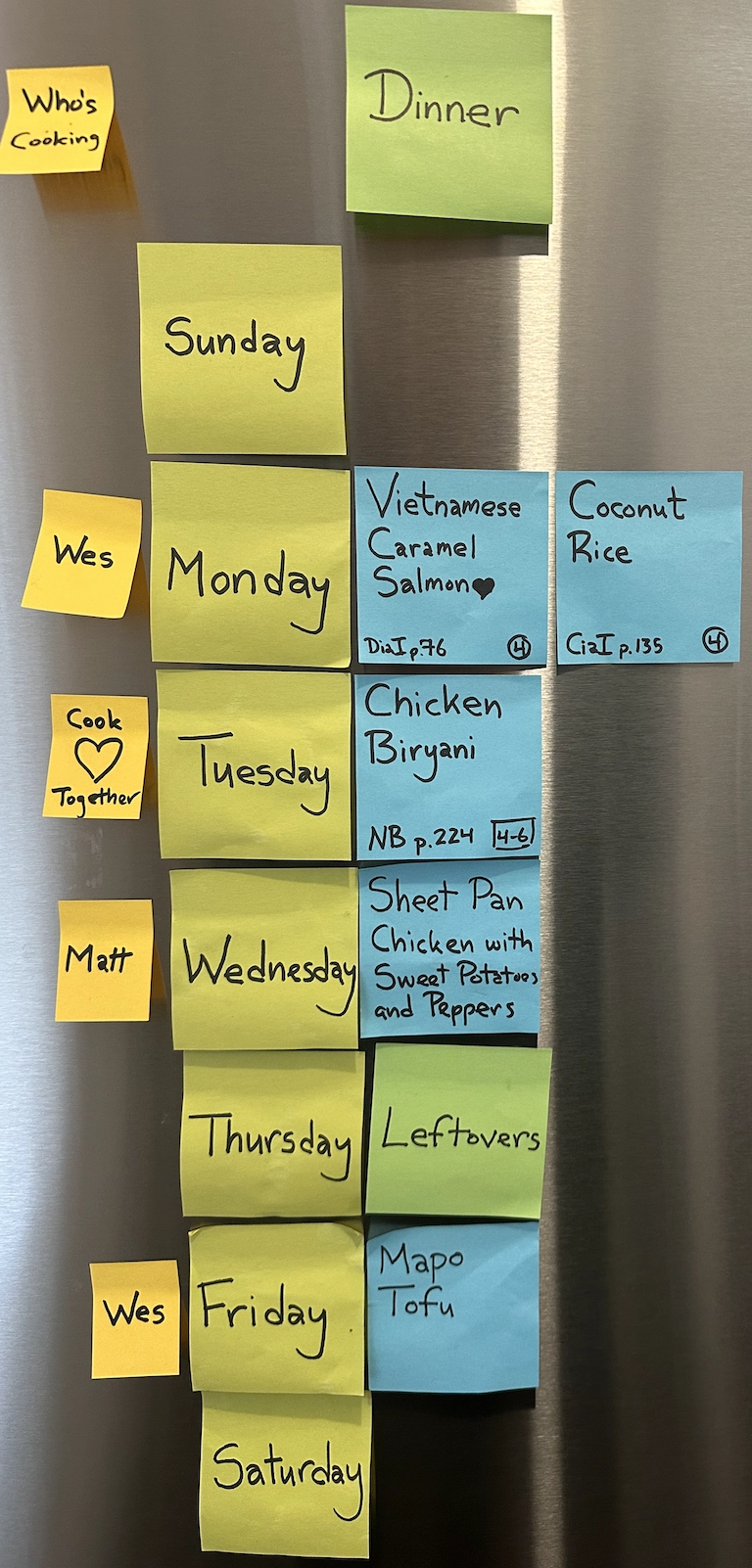
There’s a grid of post-it notes where each row represents a day of the week, each column represents a meal (e.g., breakfast, lunch, dinner), and each cell is a meal. It’s fast, simple, collaborative, and easy to maintain. We can move meals around as we’re planning and experiment with different scenarios. At the end of the planning session, we both understand what we’re going to cook, when we’re going to cook it, and who’s cooking. Importantly, we also keep an “Order In / Eat Out” post-it note around for when we make spontaneous social plans or just end up exhausted unexpectedly. When this happens we do make sure to check that the ingredients won’t spoil if we delay cooking and move things into the freezer appropriately.
We create a new post-it note each time we try a new recipe. If we like it, it goes into the library of post-it notes above the fridge so that we can plan our meals for the week easily. For new recipes, we’ll put the name, cookbook name, page number, and servings of food to make it easier to plan.
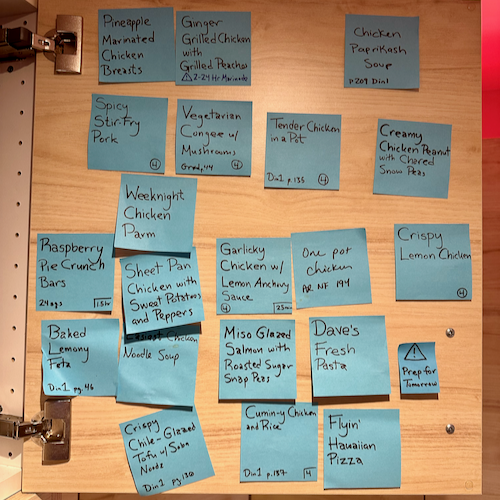
Grocery Shopping: Making a Better List
Now that we had a good system for planning out meals, I wanted to improve our grocery shopping experience. Here were some of the goals I had:
- avoid having to go to recipes for each grocery run and write down or type up the ingredients we needed every time
- allow us to split up in the grocery store to gather items
- keep us in sync on the state of the grocery list (i.e., what had the other person already picked up?)
It became clear that if we wanted to avoid re-creating lists from scratch each trip and wanted to be able to split up in the store to cover more ground faster that we would need an electronic solution. I still wanted to keep it as simple as possible and avoid buying something new. We’re both iPhone users, so I built a system with Apple Reminders and Apple Shortcuts. The solution ended up addressing most of our needs, with a few drawbacks. Let’s talk about Reminders first. It’s configured such that:
- Every recipe we shop for is added as a Reminder to a List called Recipes (e.g., Mapo Tofu).
- Each Recipe is tagged with a recipe type (e.g., #dinner, #dessert).
- Each recipe has sub-items that represent each ingredient and the amount needed for the recipe (e.g., “Tofu (soft) (2)”, “Beef (500g)”.
- Each ingredient is tagged with the section of the grocery store it lives in (e.g., #produce, #dairy, #cheese, #frozen)
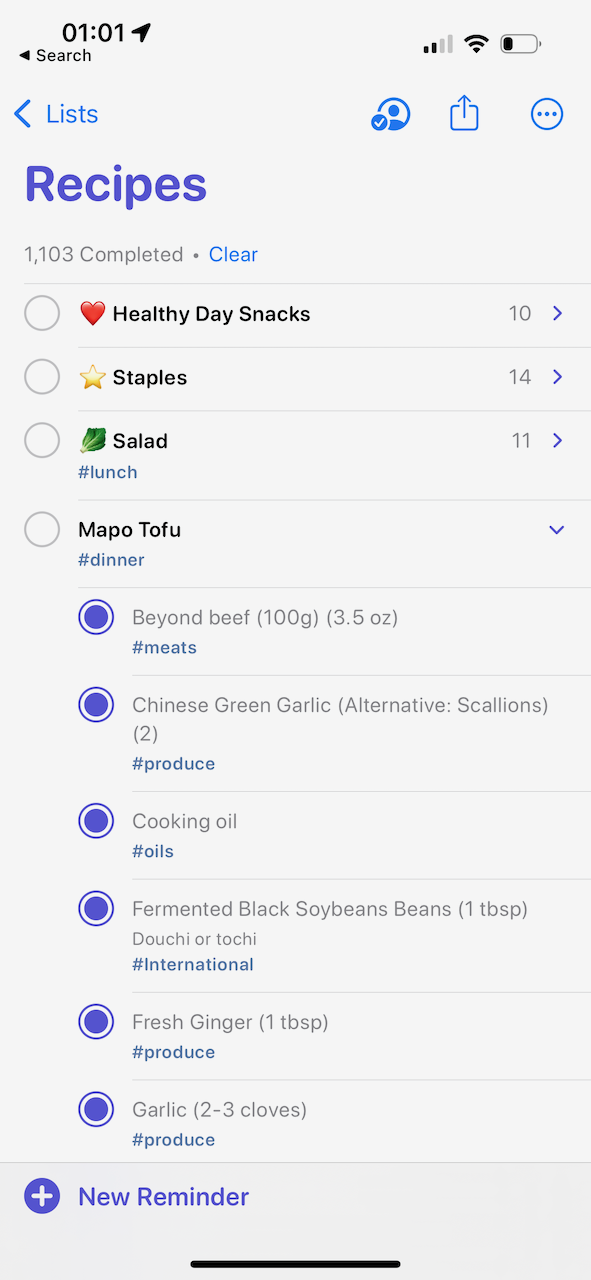
With this setup, our grocery shopping planning workflow looks like this:
- Complete post-it note planning exercise to select our meals.
- Uncheck (i.e., mark as incomplete) the recipes we’re cooking for the week.
- Go through each recipe and uncheck ingredients that we need to go out and buy as we check our fridge and cabinets.
This is nice because we can quickly assemble a list of ingredients based on recipe, but this recipe-based view isn’t great for actually shopping in the store. This is where we use Smart Lists.
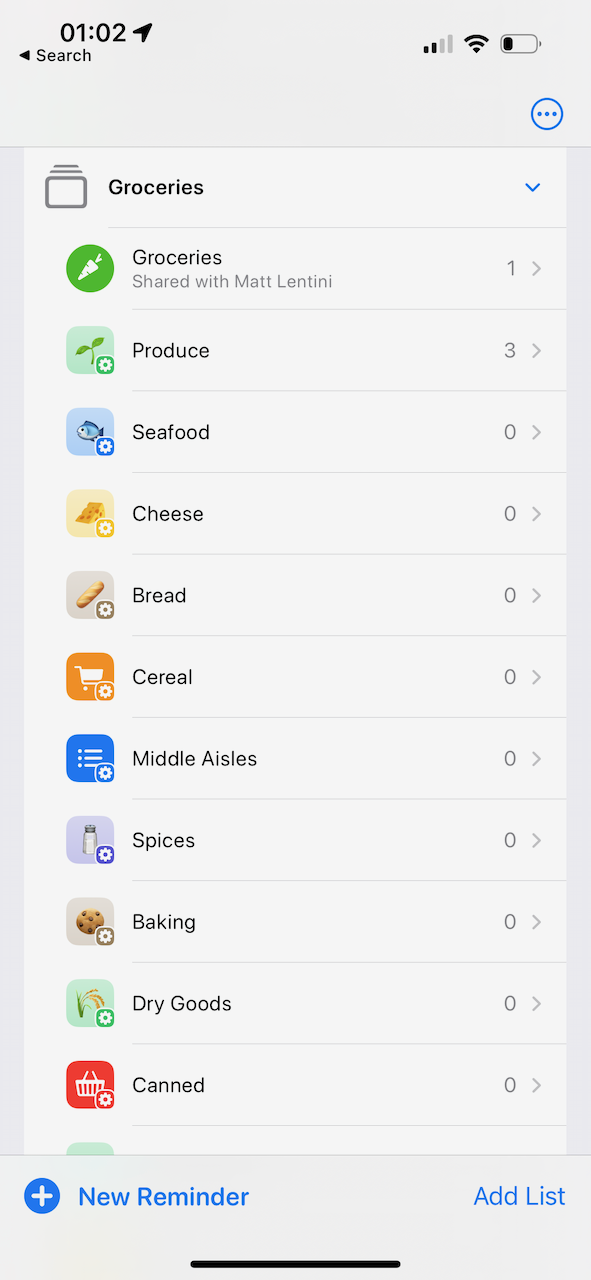
Because each ingredient is tagged, we could create a Smart List for each aisle based on the tag (e.g., #produce, #prozen). Then, I could simply navigate to the #produce smart list and it will show me all ingredients that I need to grab across all recipes we’re cooking. This is awesome, but switching between smart lists in the store could be improved.
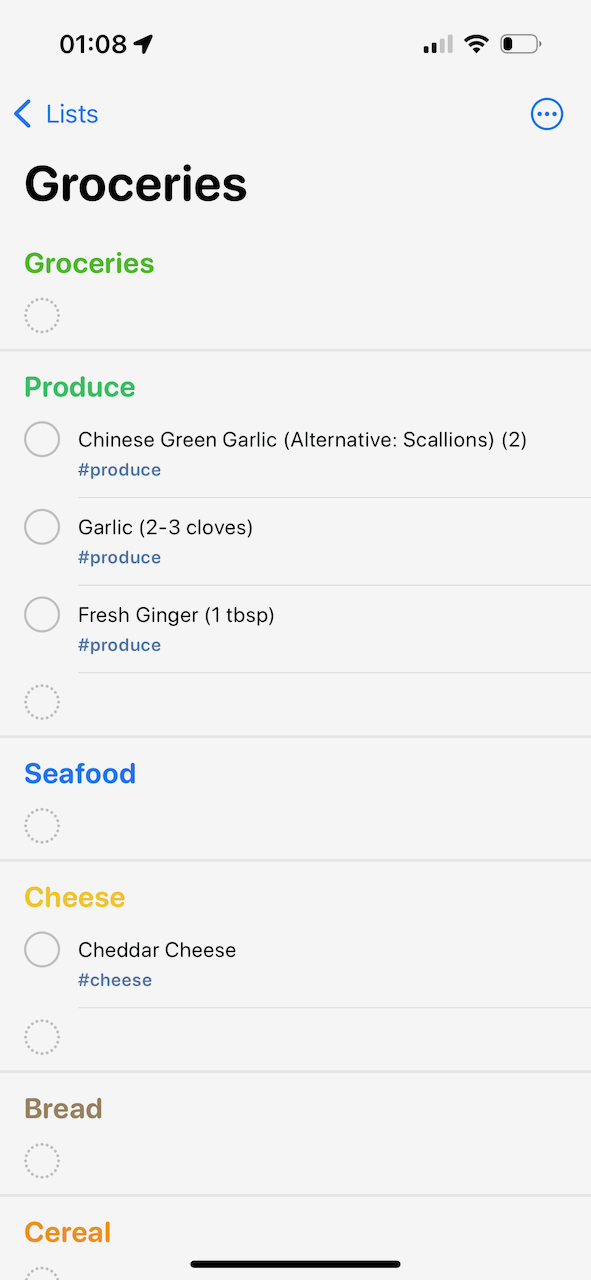
Within Apple Reminders, you can group regular lists or smart lists into folders. Then, when you view the folder, you can see a super list of all the sub-lists combined. All of our smart lists are grouped into a folder called “Groceries” so we can see a super list of all ingredients we need to pick up. Even better, the super list shows the headers for each smart list and arranges them in order that they exist within the folder. We have all the smart lists appear in the order that we walk through the grocery store. We often stay in the same section together and split up to grab items, but we can also move throughout the store independently if needed.
For items that don’t fall into a particular recipe, we have another list called Groceries that acts as a catch-all for anything else we need to get. With this setup, I can say, “Hey Siri, add Olive Oil to the Groceries list” when we’re in the middle of cooking and get an audible confirmation that it’s on the list for our next grocery run. The new item isn’t tagged, but the “Groceries” list lives at the top the “Groceries” folder, so all items show up at the top of the folder view above the smart list items.
The biggest limitations of this system is that tags are not shared between users on Apple Reminders, so I have the smart list setup, but my partner can only see the ingredients by recipe list. It’s not perfect, but it’s a huge improvement over our previous approaches.
Grocery Shopping: Adding New Recipes to Reminders
Once we experimented with the list based system for a few weeks and were happy with it, I wanted to make it easier to add new recipes to the list. It’s not a big deal to type in the ingredients for a new list, but figuring out how to make it faster and easier was fun. I created a Shortcut in Apple Shortcuts that would:
- ask for the recipe name, author, source, page number or URL, and number of servings
- create a reminder on our Recipes list in Apple Reminders based on this information
- ask for a list of ingredients where each ingredient is on a new line
- take the ingredients and add them as sub-tasks on the new recipe on the Recipes list.
On macOS or iOS, I can open the shortcut and then paste in the ingredients and the shortcut will do the rest to create each ingredient item. I still have to go into the recipe and tag each of the ingredients based on the smart list I want (e.g., #produce), but it’s still better than doing everything manually!
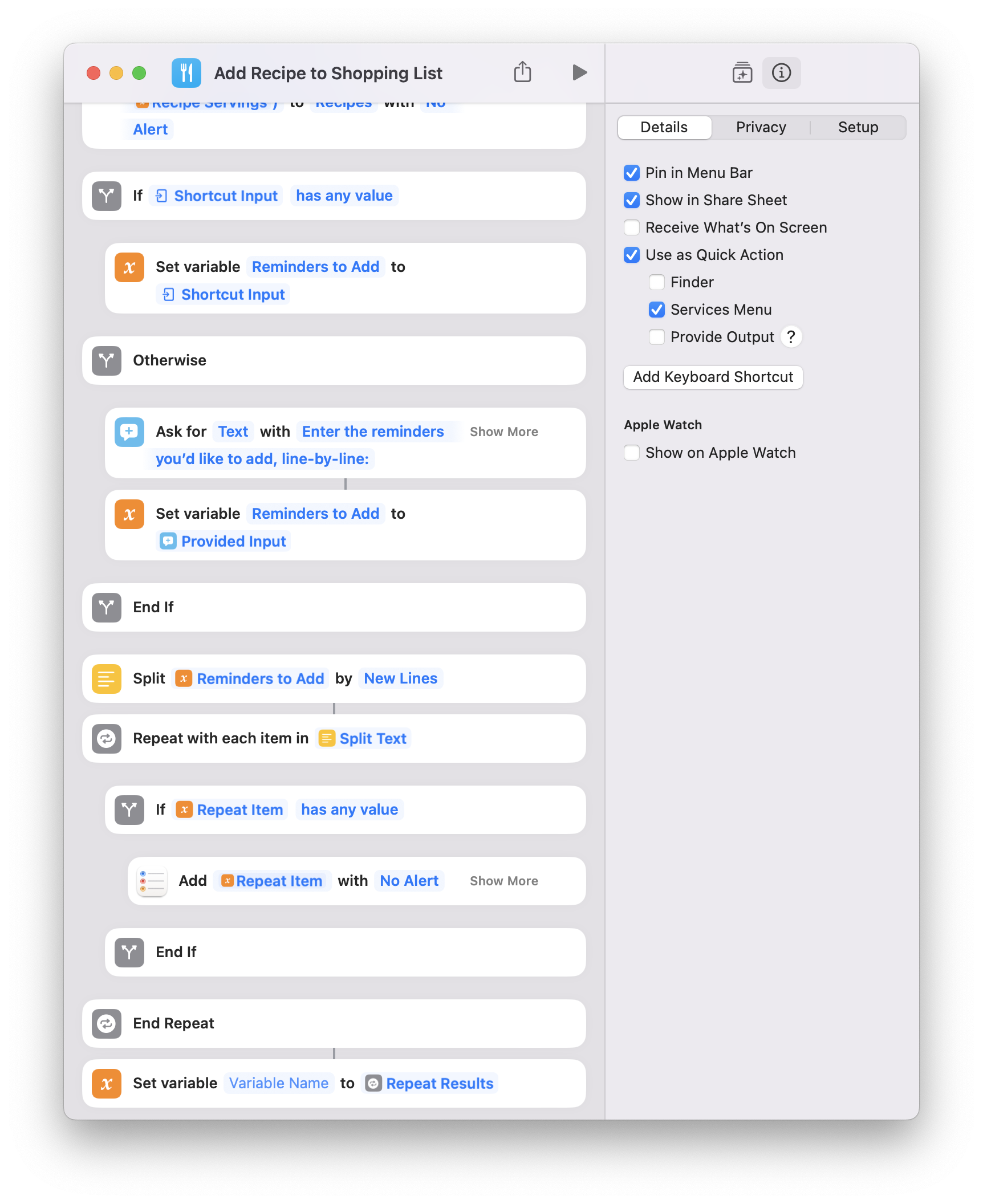
You can download a copy here: Add Recipe to Shopping List Shortcut. You just need to have a Reminders list called “Recipes” for it to work. (At your own risk! I can’t support or provide a warranty on this.)
Results
I’m thrilled with how this has all turned out. Planning our meals is easy, grocery shopping is a breeze, and (most importantly!) we’re cooking at home a lot more. Because we’ve made all of these things so much easier, we also feel prepared to experiment with new recipes more often. And just like any good plan, it’s flexible. If we don’t feel like cooking or social opportunities come up, we can move things around. I do hope that this was helpful and inspires you to come up with a system for something that’s been vexing you. I’d love to hear from you if this was helpful or if you have suggestions for improvements.
👨🏼💻 While you're here, I’m looking for my next role!
In my professional life I'm an empathetic, value-focused IT Leader who loves to help small and midsize companies transform internal IT into a strategic capability. You can learn more on my professional summary page. Do you know of a company that could benefit from my expertise? I'd love to chat!